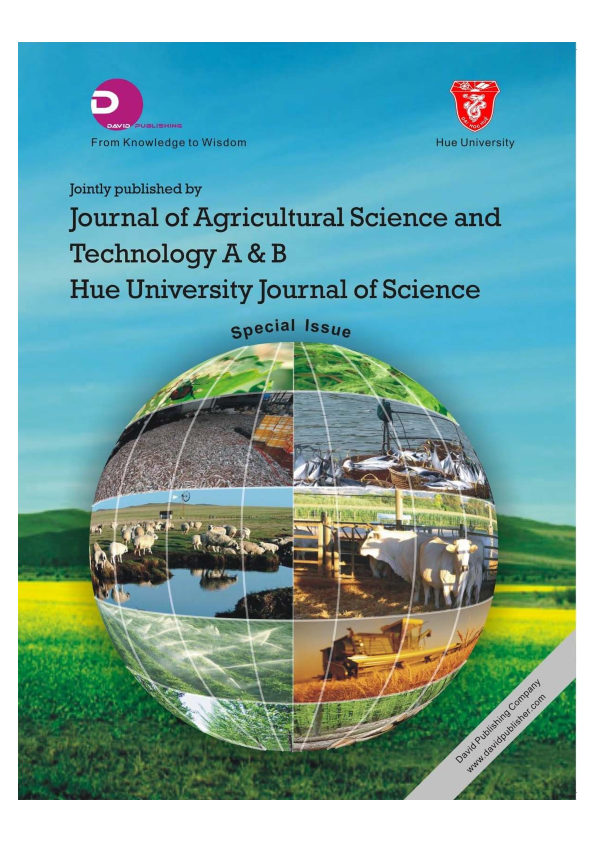Photosynthetic responses of Sweet Sorghum cultivars to Cadmium toxicity
Abstract
In this study photosynthetic modification of sweet sorghum was studied in response to heavy metal Cadmium (Cd) under greenhouse conditions. The experiment was concentrated specifically on Keller (KE) and Etian (ET), two cultivars of sweet Sorghum. The plants subjected to 100 mg kg-1 Cd in soil were compared with the control plants without Cd treatment. The results indicated that both cultivars of sweet sorghum display similar photosynthetic responses to Cd exposure. The high Cd concentration resulted in significant decline of photosynthesis net rate (Pn). The Pn of Cd treated plants was reduced compared with control plants, from 5.29% to 16.7 % in KE and from 27.3% to 29.4% in ET. Moreover, Cd treated plants were detected to have lower stomata conductance (gs) but slightly higher intercellular CO2 concentrations (Ci) than control plants. Chlorophyll content also displayed significant difference between the control plants and Cd treated plants. In ET, compared to the controls, the reduction of both chlorophyll-a and chlorophyll-b was observed under Cd stress. In contrast, chlorophyll content was significantly enhanced by Cd stress in KE. An increase of chlorophyll content occurred after Cd exposure, from 5.08 mg/g FW in control plants to 6.43mg/g FW in Cd treated plants.
References
Anna M., (2012), Plant responses to heavy metal toxicity. In book “Plants and Heavy Metals”, SpringerBriefs in Biometals, DOI: 10.1007/978-94-007- 441-7-2.
Chen X, Wang J. , Zhao Y., (2011). Effects of cadmium on growth and photosynthetic activities in pakchoi and mustard. Botanical Studies 52: 41-46.
Cheng S., (2003). Effects of heavy metals on plants resistance mechanisms. ESPR – Environ Sci& Pollut Res 10 (4) 256-264.
Garbisu C., Alkorta (2003) Basic concepts on heavy metal soil bioremediation. Eur. J. Min. Proc. & Environ, Protect. 3: 58–66
Guo D., Guo Y., Zhao J., Liu H., Peng Y., Wang. Q., Chen J., Rao G., (2005). Photosynthetic rate and chlorophyll fluorescence in leaves of stem mustard (Brassica juncea var. tsatsai) after turnip mosaic virus infection . Plant Science 168,57–63
Hiroyuki K., Shigemitsu K. , Hisahito O., Syuntaro H. (2013). Evaluation of Brix and sugar content in stem juice from sorghum varieties. Grassland Science. Volume 59, Issue 1, pages 11–19.
Kamelia M., Yuliana M. (2012). Photosynthesis and growth response of Paulownia tomentosa x fortunei hybrid plants to different levels of heavy metals Cd, Pb and Zn. Journal of Plant Nutrition.
Etim. E. E (2012) Phytoremediation and Its Mechanisms: A Review. International Journal of Environment and Bioenergy, , 2(3): 120-136
Kalaji. H.M., Loboda T. (2007). Photosystem II of barley seedlings under cadmium and lead stress. Plant Soil environ, 53 (12): 511–516
Kulkarni L.R., Narayna, R. and Krishna Sastry, K.S., (1981). Photosynthetic efficiency and translocation in relation to leaf characters and productivity in sorghum genotypes. Sorghum Newsletter. 24, p: 124-125.
Manzer H. Siddiqui, Mohamed H. Al-Whaibi, Ahmed M. Sakran, Mohammed O. Basalah, and Hayssam M. Ali. (2012). Effect of Calcium and Potassium on Antioxidant System of Vicia faba L. Under Cadmium Stress. IntJ Mol Sci.3(6): 6604–6619.
Liu D., Hu K., Ma J, Qiu W., Wang X.and Zhang S. (2011). Effects of cadmium on the growth and physiological characteristics of sorghum plants, African Journal of Biotechnology Vol. 10(70), pp. 15770-15776.
Lichtenthaler, H. K., and Wellburn (1983), A.R.,Determination of total carotenoids and chlorophylls a and b of leaf in different solvents. Biol. Soc. Trans. 11, p: 591-592.
Revathi. S, Subhashree V., (2013). Physiological and biochemical mechanisms of heavy metal tolerance. International Journal of Environmental Siences Volume 3, No5.
Roohi E., Tahmasebi-Sarvestani Z., Modarres-Sanavy S.A.M., and Siosemardeh A. (2013). Comparative Study on the Effect of Soil Water Stress on Photosynthetic Function of Triticale, Bread Wheat, and Barley. J. Agr. Sci. Tech. Vol. 15: 215-228.
Petr . Jakub Ne., Lukáš P., Šárka P., (2013). The Sorghum Plants Utilization For Accumulation of Heavy Metals. 3rd International Conference on Energy and Environmental Science IPCBEE vol.54, IACSIT Press, Singapore.
Pinto AP., A.deVarennes, Goncalves M.L.S, Mota A.M. (2006). Sorghum detoxification mechanisms. Journal Plant Nutrition 29, 1229.1242.
Prasad M.N.V, Strzalka K (1999). Impact of heavy metals on photosynthesis. “Heavy metal stress in plants” Book, p 117-138. Publisher Springer Berlin Heidelberg. DOI 10.1007/978-3-662-07745-0_6.
Zheng L., Guo X., He B., Sun L., Peng Y., Dong S., Liu T., Jiang, S. Srinivasan R., Liu C. and Jing H.(2011) Genome-wide patterns of genetic variation in sweet and grain sorghum (Sorghum bicolor). Genome Biology, 12:R114
Zhuang P., Shu W., Li Z., Liao B., Li J. , Shao J., (2009). Removal of metals by sorghum plants from contaminated land. Journal of Environmental Sciences 21.1432–1437.

